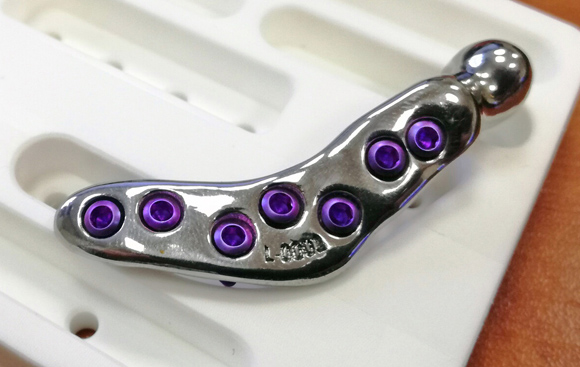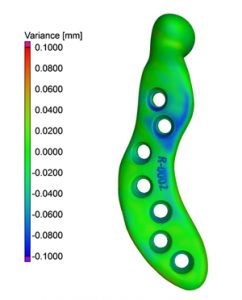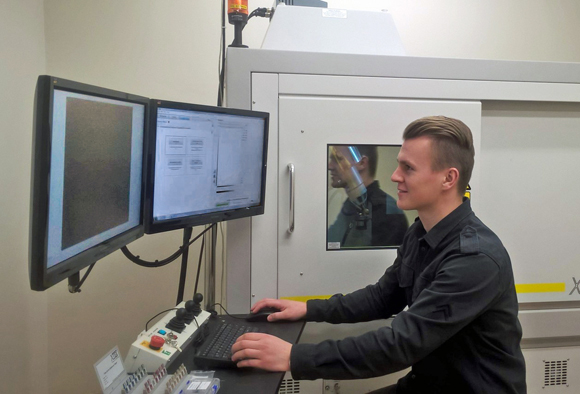CT inspection advances production of bespoke metal additively manufactured medical implants
April 25, 2017

An additively manufactured implant produced by Ortho Baltic (Courtesy Nikon)
Lithuanian-based medical company Ortho Baltic reports that it has commenced the Additive Manufacturing of patient-specific temporomandibular joint endoprostheses. The implants are designed to replace loss or lack of functionality of jaw movement. The firm reportedly invested in metal Additive Manufacturing technology in 2012 and has recently acquired Nikon Metrology Computed Tomography (CT) inspection equipment for quality control.
Ortho Baltic has stated that it endeavours to move away from a ‘one implant fits all’ mindset towards tailored solutions for medical devices and to make patient-specific implants affordable and available for all patients and national healthcare systems. The company also designs and produces patient-specific joints, cranial and spinal implants, bone plating systems, dental and jaw restoration implants and surgical guides.

Medical CT scans are used to prepare the CAD model, while a micro-CT scanner is used to inspect AM parts (Courtesy Nikon Metrology)
The company’s Implant Design and Development Centre, in which the new prostheses are being developed, relies on various AM processes for the different types of component produced. Implants are typically made from medical Grade-5 titanium alloy Ti6Al4V by direct laser metal sintering. X-ray also plays an important role in the process: medical CT scans are used to prepare the CAD model, while a Nikon Metrology industrial, high voltage, micro-CT scanner is used to inspect additively manufactured parts.
Milda Jokymaitytė, clinical engineer at Ortho Baltic, explained, “To create anatomical models, 3D reconstruction engineers use the patient’s radiological data to perform a 3D reconstruction. The anatomical bone structures are segmented and virtual 3D models prepared. Including printing, quality control, packaging and sterilisation, the usual lead-time for a patient-specific jaw joint implant is approximately four weeks following the surgeon’s approval of the final design. From this point onwards, pre-surgical planning commences between patient and surgeon, ultimately leading to surgery completion.”
An important challenge is the quality assurance of AM components. Especially in the medical field, the quality, fit and functionality of implants and other medical components is vital. Domantas Ozerenskis, product quality manager at Ortho Baltic, stated, “Currently, micro-CT is the best solution for our product development and quality control. 3D-printing is a complicated technology and there is a large variety of processing parameters, so it is very hard to predict the quality and geometry.”
The Nikon Metrology XT H 225 micro-CT scanner used in quality inspection at Ortho Baltic has a 225 kV micro-focus source that reveals, non-destructively, any voids, cracks and other defects in the complex internal features of AM components. Scan data is compared against the original CAD design to reveal any deviations.

A member of Ortho Baltic’s team uses Nikon Metrology’s micro-CT scanner to inspect AM parts (Courtesy Nikon Metrology)
“Micro-CT scanning is the only way to check non-destructively for voids and cracks inside a part,” added Ozerenskis. “We considered a coordinate measuring machine, but it is inconvenient for taking non-parametric measurements and there is no possibility for inner structure investigation. The internal quality of implants is very important, as it determines the mechanical strength of the part.”
Ortho Baltic requires at an energy source of at least 200 kV to penetrate the dense materials it uses. A large workplace area, capable of holding a range of large and heavy components, is also required, as component sizes vary for each patient and procedure. According to the company, the Nikon Metrology XT H 225 is ideal in this respect, used together with a Varian 4030 digital panel and Inspect-X software.
In comparison to standard implants previously sourced from the USA, the firm reports that it has been able to produce its implants to the same high quality at almost half the cost. Maxillofacial surgeon, S Bojarskas, commented, “Apart from needing more extensive planning, the AM product itself is no different in terms of quality.”
“Nominal CAD to actual 3D-printed implant comparison, geometry inspection and void detection are irreplaceable for our quality control,” concluded Ozerenskis. “The Nikon solution offers better knowledge of what we are manufacturing and gives superior precision and understanding of 3D printing errors and deviations. After 3D metal printing, post-processes such as sandblasting and polishing often remove thick surface layers up to 200 microns – even more in the case of other manual processes. What micro-CT data has also helped to do is adjust our CAD and 3D printing protocols to get the most accurate geometry for all our AM parts.”
















